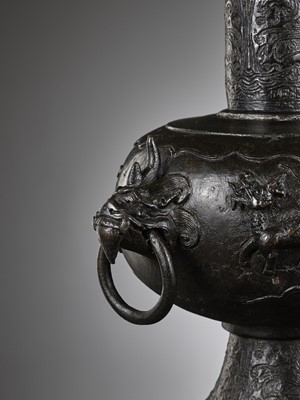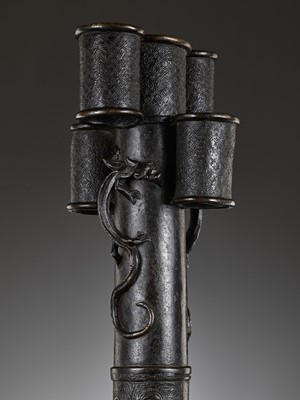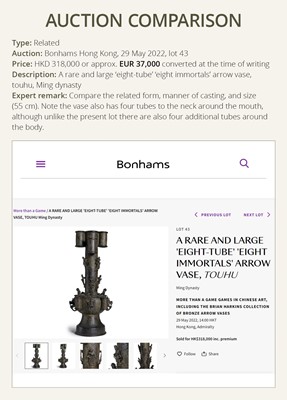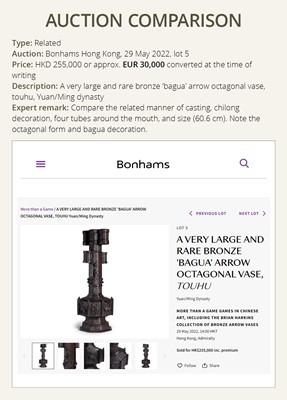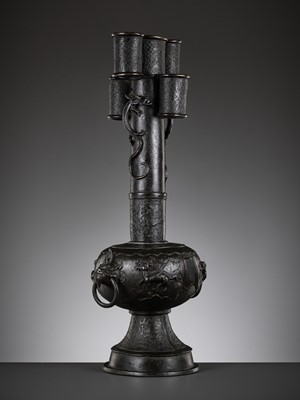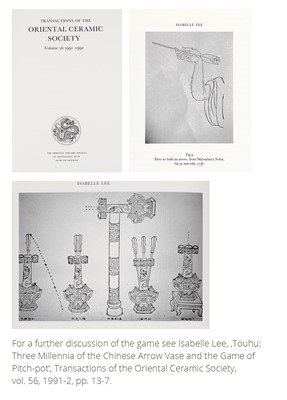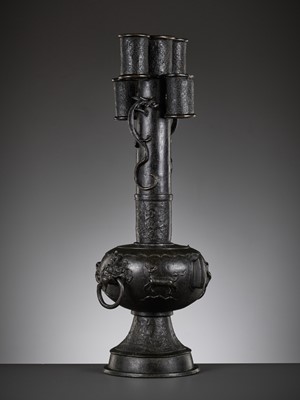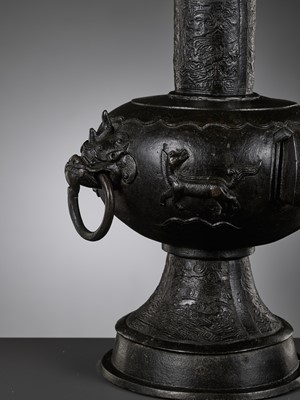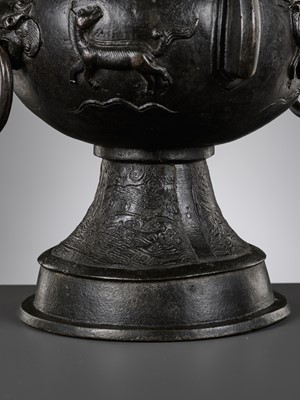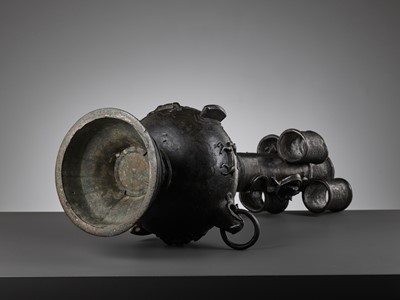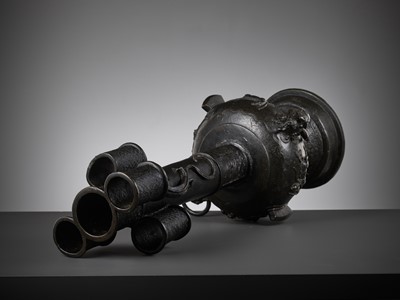9th Mar, 2023 13:00
TWO-DAY AUCTION - Fine Chinese Art / 中國藝術集珍 / Buddhism & Hinduism
150
A LARGE BRONZE ‘CHILONG’ FOUR-TUBE ARROW VASE, TOUHU, YUAN TO MING DYNASTY
元至明大型螭龍紋四貫耳投壺
Sold for €14,300
including Buyer's Premium
China, 1279-1644. Heavily cast with a compressed globular body rising from a stepped foot and surmounted by a tall slender cylindrical neck, with four tubular rings surrounding the mouth. The body cast in relief with two beast masks suspending loose rings flanked by qilin and short flanges, the neck similarly cast with two chilong dragons. The foot and base of the neck decorated with archaistic motifs.
Provenance: Swedish trade.
Condition: Good condition with minor wear and casting irregularities, few minuscule nicks and dents here and there. The body and neck cast separately and joined together, with the neck being somewhat loosened. Excellent, naturally grown patina overall.
Weight: 10 kg
Dimensions: Height 58.5 cm
Vases such as the present lot were designed for the ancient Chinese game of touhu, or 'arrow-throwing', which would form part of the entertainment at banquets and is mentioned in early classical texts such as the Chunqiu Zuo Zhuan attributed to Zuoqiu Ming (c.556-451 BC). Contestants would aim feathered arrows at the various cylinders applied to the vase, with higher points awarded for the less accessible openings. The loser was made to drink wine, leading to increased inebriation and diminished throwing accuracy.
Literature comparison:
See a related bronze arrow vase, dated as first half 17th century, illustrated in The Chinese Scholar's Studio: Artistic Life in the Late Ming Period, New York, 1987, no. 63. For a similar example, see Chinesische Kunstgeschichte von Oskar Münsterberg, Esslingen, 1910, p. 136.
Auction result comparison:
Type: Related
Auction: Bonhams Hong Kong, 29 May 2022, lot 43
Price: HKD 318,000 or approx. EUR 37,000 converted at the time of writing
Description: A rare and large ‘eight-tube’ ‘eight immortals’ arrow vase, touhu, Ming dynasty
Expert remark: Compare the related form, manner of casting, and size (55 cm). Note the vase also has four tubes to the neck around the mouth, although unlike the present lot there are also four additional tubes around the body.
Auction result comparison:
Type: Related
Auction: Bonhams London, 6 November 2014, lot 388
Price: GBP 18,750 or approx. EUR 27,000 converted and adjusted for inflation at the time of writing
Description: A large and unusual bronze ‘arrow’ vase, touhu, Ming dynasty
Expert remark: Compare the related form, manner of casting, chilong decoration, and size (55 cm). Note the vase also has four tubes to the neck around the mouth, although unlike the present lot two of them are slanted and there are also four additional tubes around the body.
Auction result comparison:
Type: Related
Auction: Bonhams Hong Kong, 29 May 2022, lot 5
Price: HKD 255,000 or approx. EUR 30,000 converted at the time of writing
Description: A very large and rare bronze ‘bagua’ arrow octagonal vase, touhu, Yuan/Ming dynasty
Expert remark: Compare the related manner of casting, chilong decoration, four tubes around the mouth, and size (60.6 cm). Note the octagonal form and bagua decoration.
Arrow vases were made for a drinking game called 'touhu', which had been popular among elite men and women from the Spring and Autumn period (770-476 BC). Players threw arrows into bronze or ceramic vases with narrow tubular necks at prescribed intervals, each player equidistant from the vase. The winner successfully projected all his arrows into the vase and the loser was forced to drink at each miss. Elaborate rituals and intricate rules, recorded in the Li Ji (Book of Rites), added further complexity to the game. Puzzling pitching techniques were described in the Touhu Yijie (Ceremonial Usages and Rules of Touhu), an illustrated manual written by Wang Ti (1490-1530), and these shots were given fancy names, like ‘A Pair of Dragons Enters the Sea’ when two arrows were thrown from a great height at once into the vase. The touhu game was used to practice archery, one of the essential accomplishments of a gentleman. Later in the Ming era, the game became more widespread and was played by rich merchants as well as the aristocracy and scholarly elite. A scene in the famous late Ming novel Jin Ping Mei (Plum Blossom in the Golden Vase), written in 1619, describes the wealthy merchant Ximen Qing's seduction of his concubine Panjinlian. She becomes inebriated while playing touhu on a picnic and the game leads to an amorous encounter. For a further discussion of the game see Isabelle Lee, 'Touhu: Three Millennia of the Chinese Arrow Vase and the Game of Pitch-pot', Transactions of the Oriental Ceramic Society, vol. 56, 1991-2, pp. 13-7.
元至明大型螭龍紋四貫耳投壺
中國,1279-1644年。投壺唇口,口沿兩側附雙貫耳,形成三個並列的口部,其下頸部兩側一對貫耳。壺身修飾螭龍等,中部鼓腹,龍耳活環。各部紋飾錯落有致。
來源:瑞典古玩交易。
品相:狀況良好,有輕微磨損和鑄件不規則處,輕微刻痕和凹痕。壺身與頸部分體鑄合,頸稍鬆。包漿良好。
重量:10 公斤
尺寸:高58.5 厘米
文獻比較:
一件相近的十七世紀上半葉貫耳投壺,見《The Chinese Scholar's Studio: Artistic Life in the Late Ming Period》,紐約,1987年,編號63。一件相似的例子,見《Chinesische Kunstgeschichte von Oskar Münsterberg》,埃斯林根,1910年,頁136。
拍賣結果比較:
形制:相近
拍賣:香港邦瀚斯,2022年5月29日,lot 43
價格:HKD 318,000(相當於今日EUR 37,000)
描述:明銅八仙八貫耳投壺
專家評論:比較相近的外形、鑄造風格和尺寸 (55 厘米)。請注意瓶口旁有四口,與現在的拍品不同。
拍賣結果比較:
形制:相近
拍賣:倫敦邦瀚斯,2014年11月6日,lot 388
價格:GBP 18,750(相當於今日EUR 27,000)
描述:明銅饕餮紋投壺
專家評論:比較相近的外形、鑄造風格、螭龍裝飾和尺寸 (55 厘米)。請注意瓶口旁有四口,瓶身還有數個貫口。
拍賣結果比較:
形制:相近
拍賣:香港邦瀚斯,2022年5月29日,lot 5
價格:HKD 255,000(相當於今日EUR 30,000)
描述:元/明銅八方八卦獸紋投壺
專家評論:比較相近的鑄造風格、螭龍裝飾、瓶口旁有四口和尺寸 (60.6 厘米)。請注意八角形的外形和八卦裝飾。
China, 1279-1644. Heavily cast with a compressed globular body rising from a stepped foot and surmounted by a tall slender cylindrical neck, with four tubular rings surrounding the mouth. The body cast in relief with two beast masks suspending loose rings flanked by qilin and short flanges, the neck similarly cast with two chilong dragons. The foot and base of the neck decorated with archaistic motifs.
Provenance: Swedish trade.
Condition: Good condition with minor wear and casting irregularities, few minuscule nicks and dents here and there. The body and neck cast separately and joined together, with the neck being somewhat loosened. Excellent, naturally grown patina overall.
Weight: 10 kg
Dimensions: Height 58.5 cm
Vases such as the present lot were designed for the ancient Chinese game of touhu, or 'arrow-throwing', which would form part of the entertainment at banquets and is mentioned in early classical texts such as the Chunqiu Zuo Zhuan attributed to Zuoqiu Ming (c.556-451 BC). Contestants would aim feathered arrows at the various cylinders applied to the vase, with higher points awarded for the less accessible openings. The loser was made to drink wine, leading to increased inebriation and diminished throwing accuracy.
Literature comparison:
See a related bronze arrow vase, dated as first half 17th century, illustrated in The Chinese Scholar's Studio: Artistic Life in the Late Ming Period, New York, 1987, no. 63. For a similar example, see Chinesische Kunstgeschichte von Oskar Münsterberg, Esslingen, 1910, p. 136.
Auction result comparison:
Type: Related
Auction: Bonhams Hong Kong, 29 May 2022, lot 43
Price: HKD 318,000 or approx. EUR 37,000 converted at the time of writing
Description: A rare and large ‘eight-tube’ ‘eight immortals’ arrow vase, touhu, Ming dynasty
Expert remark: Compare the related form, manner of casting, and size (55 cm). Note the vase also has four tubes to the neck around the mouth, although unlike the present lot there are also four additional tubes around the body.
Auction result comparison:
Type: Related
Auction: Bonhams London, 6 November 2014, lot 388
Price: GBP 18,750 or approx. EUR 27,000 converted and adjusted for inflation at the time of writing
Description: A large and unusual bronze ‘arrow’ vase, touhu, Ming dynasty
Expert remark: Compare the related form, manner of casting, chilong decoration, and size (55 cm). Note the vase also has four tubes to the neck around the mouth, although unlike the present lot two of them are slanted and there are also four additional tubes around the body.
Auction result comparison:
Type: Related
Auction: Bonhams Hong Kong, 29 May 2022, lot 5
Price: HKD 255,000 or approx. EUR 30,000 converted at the time of writing
Description: A very large and rare bronze ‘bagua’ arrow octagonal vase, touhu, Yuan/Ming dynasty
Expert remark: Compare the related manner of casting, chilong decoration, four tubes around the mouth, and size (60.6 cm). Note the octagonal form and bagua decoration.
Arrow vases were made for a drinking game called 'touhu', which had been popular among elite men and women from the Spring and Autumn period (770-476 BC). Players threw arrows into bronze or ceramic vases with narrow tubular necks at prescribed intervals, each player equidistant from the vase. The winner successfully projected all his arrows into the vase and the loser was forced to drink at each miss. Elaborate rituals and intricate rules, recorded in the Li Ji (Book of Rites), added further complexity to the game. Puzzling pitching techniques were described in the Touhu Yijie (Ceremonial Usages and Rules of Touhu), an illustrated manual written by Wang Ti (1490-1530), and these shots were given fancy names, like ‘A Pair of Dragons Enters the Sea’ when two arrows were thrown from a great height at once into the vase. The touhu game was used to practice archery, one of the essential accomplishments of a gentleman. Later in the Ming era, the game became more widespread and was played by rich merchants as well as the aristocracy and scholarly elite. A scene in the famous late Ming novel Jin Ping Mei (Plum Blossom in the Golden Vase), written in 1619, describes the wealthy merchant Ximen Qing's seduction of his concubine Panjinlian. She becomes inebriated while playing touhu on a picnic and the game leads to an amorous encounter. For a further discussion of the game see Isabelle Lee, 'Touhu: Three Millennia of the Chinese Arrow Vase and the Game of Pitch-pot', Transactions of the Oriental Ceramic Society, vol. 56, 1991-2, pp. 13-7.
元至明大型螭龍紋四貫耳投壺
中國,1279-1644年。投壺唇口,口沿兩側附雙貫耳,形成三個並列的口部,其下頸部兩側一對貫耳。壺身修飾螭龍等,中部鼓腹,龍耳活環。各部紋飾錯落有致。
來源:瑞典古玩交易。
品相:狀況良好,有輕微磨損和鑄件不規則處,輕微刻痕和凹痕。壺身與頸部分體鑄合,頸稍鬆。包漿良好。
重量:10 公斤
尺寸:高58.5 厘米
文獻比較:
一件相近的十七世紀上半葉貫耳投壺,見《The Chinese Scholar's Studio: Artistic Life in the Late Ming Period》,紐約,1987年,編號63。一件相似的例子,見《Chinesische Kunstgeschichte von Oskar Münsterberg》,埃斯林根,1910年,頁136。
拍賣結果比較:
形制:相近
拍賣:香港邦瀚斯,2022年5月29日,lot 43
價格:HKD 318,000(相當於今日EUR 37,000)
描述:明銅八仙八貫耳投壺
專家評論:比較相近的外形、鑄造風格和尺寸 (55 厘米)。請注意瓶口旁有四口,與現在的拍品不同。
拍賣結果比較:
形制:相近
拍賣:倫敦邦瀚斯,2014年11月6日,lot 388
價格:GBP 18,750(相當於今日EUR 27,000)
描述:明銅饕餮紋投壺
專家評論:比較相近的外形、鑄造風格、螭龍裝飾和尺寸 (55 厘米)。請注意瓶口旁有四口,瓶身還有數個貫口。
拍賣結果比較:
形制:相近
拍賣:香港邦瀚斯,2022年5月29日,lot 5
價格:HKD 255,000(相當於今日EUR 30,000)
描述:元/明銅八方八卦獸紋投壺
專家評論:比較相近的鑄造風格、螭龍裝飾、瓶口旁有四口和尺寸 (60.6 厘米)。請注意八角形的外形和八卦裝飾。
Zacke Live Online Bidding
Our online bidding platform makes it easier than ever to bid in our auctions! When you bid through our website, you can take advantage of our premium buyer's terms without incurring any additional online bidding surcharges.
To bid live online, you'll need to create an online account. Once your account is created and your identity is verified, you can register to bid in an auction up to 12 hours before the auction begins.
Intended Spend and Bid Limits
When you register to bid in an online auction, you will need to share your intended maximum spending budget for the auction. We will then review your intended spend and set a bid limit for you. Once you have pre-registered for a live online auction, you can see your intended spend and bid limit by going to 'Account Settings' and clicking on 'Live Bidding Registrations'.
Your bid limit will be the maximum amount you can bid during the auction. Your bid limit is for the hammer price and is not affected by the buyer’s premium and VAT. For example, if you have a bid limit of €1,000 and place two winning bids for €300 and €200, then you will only be able to bid €500 for the rest of the auction. If you try to place a bid that is higher than €500, you will not be able to do so.
Online Absentee and Telephone Bids
You can now leave absentee and telephone bids on our website!
Absentee Bidding
Once you've created an account and your identity is verified, you can leave your absentee bid directly on the lot page. We will contact you when your bids have been confirmed.
Telephone Bidding
Once you've created an account and your identity is verified, you can leave telephone bids online. We will contact you when your bids have been confirmed.
Classic Absentee and Telephone Bidding Form
You can still submit absentee and telephone bids by email or fax if you prefer. Simply fill out the Absentee Bidding/Telephone bidding form and return it to us by email at office@zacke.at or by fax at +43 (1) 532 04 52 20. You can download the PDF from our Upcoming Auctions page.
How-To Guides
How to Create Your Personal Zacke Account
How to Register to Bid on Zacke Live
How to Leave Absentee Bids Online
How to Leave Telephone Bids Online
中文版本的操作指南
创建新账号
注册Zacke Live在线直播竞拍(免平台费)
缺席投标和电话投标
Third-Party Bidding
We partner with best-in-class third-party partners to make it easy for you to bid online in the channel of your choice. Please note that if you bid with one of our third-party online partners, then there will be a live bidding surcharge on top of your final purchase price. You can find all of our fees here. Here's a full list of our third-party partners:
- 51 Bid Live
- EpaiLive
- ArtFoxLive
- Invaluable
- LiveAuctioneers
- the-saleroom
- lot-tissimo
- Drouot
Please note that we place different auctions on different platforms. For example, in general, we only place Chinese art auctions on 51 Bid Live.
Bidding in Person
You must register to bid in person and will be assigned a paddle at the auction. Please contact us at office@zacke.at or +43 (1) 532 04 52 for the latest local health and safety guidelines.

